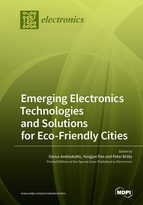Emerging Electronics Technologies and Solutions for Eco-Friendly Cities
A special issue of Electronics (ISSN 2079-9292). This special issue belongs to the section "Electrical and Autonomous Vehicles".
Deadline for manuscript submissions: closed (31 August 2022) | Viewed by 27822
Special Issue Editors
Interests: energy harvesting; interactive electronic systems; electric vehicles; integrated information systems; indirect measurement methods; reinforcement learning
Special Issues, Collections and Topics in MDPI journals
Interests: vehicle system dynamics; lightweight design of automotive components
Special Issues, Collections and Topics in MDPI journals
Interests: wireless positioning; modular positioning systems; ubiquitous positioning; satellite navigation systems; intelligent transport systems; mobile positioning; pedestrian dead reckoning; wireless communication
Special Issues, Collections and Topics in MDPI journals
Special Issue Information
Dear Colleagues,
The abundance of electronic solutions that are being developed and applied in smart cities is becoming an inevitable part of our life. On the other hand, the growing population is forcing us to look for new, more effective solutions. According to preliminary forecast and modeling results, population growth is expected to stop only at the end of this century (source: a Pew Research Center (pewresearch.org)). Rising demand for power, water supply and waste management, pedestrian safety, efficient use of electric vehicles, traffic jams, commuting, the identification of all road users and prediction of their travel path, and increasing air and noise levels are the most pressing issues in today’s cities. The place we live in has a huge impact on our lives. Advance planning is a feature of green development that reduces dependence on vehicles associated with increased greenhouse gas emissions. The development of eco-friendly cities includes the development and application of new efficient solutions and technologies such as efficient transport management, emission control and pollution control, energy efficiency and usage of renewable energy, resource efficiency, etc., and would ensure a better quality of life of the growing population.
This Special Issue aims to present high-quality research and recent advances of technologies towards eco-friendly cities.
You are invited to submit original papers on topics including but not limited to the following:
- Traffic congestion systems;
- Transportation efficiency;
- Waste management;
- Water supply;
- Energy efficiency;
- Sensors and their networks;
- Internet of Things approaches for eco-friendly cities;
- Assistance systems;
- Connected and autonomous driving;
- Emission and pollution control;
- Noise pollution control;
- Electric vehicles and bicycles sharing;
- Pedestrian safety;
- Eco-friendly cities inter-relationship with smart homes.
Prof. Dr. Darius Andriukaitis
Dr. Yongjun Pan
Prof. Dr. Peter Brida
Guest Editors
Manuscript Submission Information
Manuscripts should be submitted online at www.mdpi.com by registering and logging in to this website. Once you are registered, click here to go to the submission form. Manuscripts can be submitted until the deadline. All submissions that pass pre-check are peer-reviewed. Accepted papers will be published continuously in the journal (as soon as accepted) and will be listed together on the special issue website. Research articles, review articles as well as short communications are invited. For planned papers, a title and short abstract (about 100 words) can be sent to the Editorial Office for announcement on this website.
Submitted manuscripts should not have been published previously, nor be under consideration for publication elsewhere (except conference proceedings papers). All manuscripts are thoroughly refereed through a single-blind peer-review process. A guide for authors and other relevant information for submission of manuscripts is available on the Instructions for Authors page. Electronics is an international peer-reviewed open access semimonthly journal published by MDPI.
Please visit the Instructions for Authors page before submitting a manuscript. The Article Processing Charge (APC) for publication in this open access journal is 2400 CHF (Swiss Francs). Submitted papers should be well formatted and use good English. Authors may use MDPI's English editing service prior to publication or during author revisions.
Keywords
- eco-friendly city
- traffic congestion
- transportation system
- waste and water management
- energy efficiency
- sensors
- IoT
- emission
- pollution
- electric vehicles








